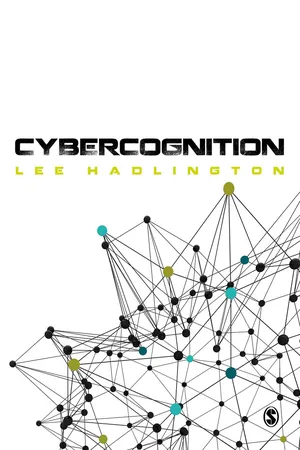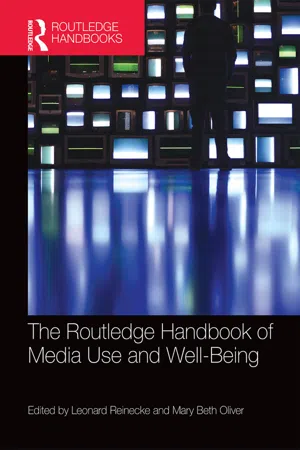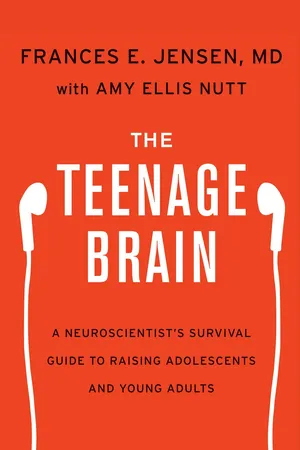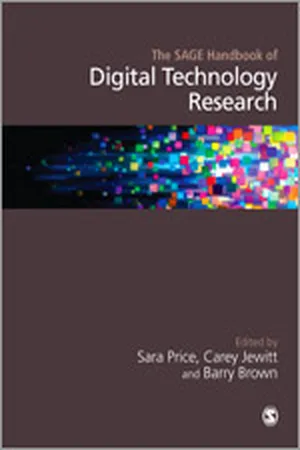Computer Science
Digital Addiction
Digital addiction refers to the excessive and compulsive use of digital devices and technology, leading to negative impacts on one's physical, mental, and emotional well-being. This can include addiction to social media, online gaming, or constant internet usage. Symptoms may include withdrawal when not using digital devices, neglect of real-life responsibilities, and a preoccupation with online activities.
Written by Perlego with AI-assistance
Related key terms
6 Key excerpts on "Digital Addiction"
- eBook - ePub
Cybercognition
Brain, behaviour and the digital world
- Lee Hadlington(Author)
- 2017(Publication Date)
- SAGE Publications Ltd(Publisher)
11 Technology Addictions and CognitionLearning Objectives
- To explore the concept of technology addiction and present an overview of the literature in the area;
- to introduce some key addictions to technology and examine how they can impact on human cognition;
- to highlight some of the key issues inherent in using broad labels for technology addictions.
Digital Addictions and the Impact on Human Cognition
One key area of research that is featured heavily in the cyberpsychology literature is the potential for individuals to become addicted to digital technology. The important question we need to start to ask ourselves is if we do become addicted, how does this addiction start to affect our capacity to focus on normal daily activities? There has been some discussion of aspects of technology addiction in other chapters of this book, with some links to the residual impact these behaviours may have on cognition. However, research that specifically focuses on evidence for addiction to digital technology and how such disorders could have an impact on our daily functioning is limited (Hadlington, 2015). In this chapter the aim is to present a very broad overview of the current state of research in the area of technology addiction. Throughout the chapter the links between these behavioural addictions and the potential impact on cognition will be established, reviewing some of the material that has already been discussed in other chapters of the book. Hopefully, you will see that there is a distinct gap in the literature in this area, and it presents great potential for further research.The Emergency of Behavioural Addictions
Previous conceptualisations of addictions have focused, for the most part, on substance abuse for things such as drugs and alcohol (Griffiths, 1998). These addictions involve the direct action of ingesting something that alters our experiences via a chemical process. However, in the 1990s a growing area of research suggested that individuals could equally become addicted to activities without the direct need to ingest drugs (Brown, 1993; Griffiths, 1996, 1998). Previous research has highlighted a number of these behavioural addictions including obsessive-compulsive disorder (OCD), compulsive spending and gambling, overeating and kleptomania to name just a few (Marks, 1990). What is apparent from the earlier work on behavioural addiction is that there is some considerable overlap to that of substance addiction. For example a ‘repeated urge to engage in a particular behaviour sequence that is counterproductive’ and ‘mounting tension until the sequence is completed’ could easily fit into any number of behavioural addictions, but which are included in the World Health Organization’s definition of substance addiction (Marks, 1990). - eBook - ePub
Internet Addiction
A Handbook and Guide to Evaluation and Treatment
- Kimberly S. Young, Cristiano Nabuco de Abreu(Authors)
- 2010(Publication Date)
- Wiley(Publisher)
With substance or alcohol abuse or dependence there are other factors, including physiological intoxication, tolerance, and withdrawal. We also know there are physically damaging results from drug or alcohol abuse. The Internet shares some but not all of these features and contains several new and unique characteristics as well. With Internet addiction we may see aspects of tolerance and withdrawal with concomitant physical discomfort (mostly in the form of anxiety-like symptoms or elevated irritability) when patients remove or alter their Internet use patterns. Many patients report such withdrawal symptoms when discontinuing or decreasing their use of the Internet and other digital media technologies; often such symptoms and reactions are corroborated by close family members and friends.Before discussing Internet addiction in more depth, a review of some general constructs of addiction is in order. The term addiction does not typically appear in the psychiatric, psychological, or addictions nomenclature. Rather, the more commonly accepted terms are abuse and dependence , with the latter marked with features of tolerance and withdrawal along with other markers of physiological habituation. To meet the criteria for what might closely resemble a substance-based addiction, there must be: (1) engaging in an intoxicating/pleasurable behavior (with an intention to alter mood and consciousness), (2) a pattern of excessive use, (3) negative or deleterious impact in a major sphere of living, and (4) the presence of tolerance and withdrawal features. There are other markers as well, but these are the most significant, comparable to compulsive gambling or other impulsive control disorders (Young, 1998b).Regardless of how we label the problem, there appears to be several central hallmarks that represent this clinical syndrome. The highlight of the Internet addictive or compulsive pattern would involve not only the presence of tolerance (requiring more time online, greater or varying degrees of stimulating content, or more frequent use) but also the presence of some form of withdrawal pattern. This withdrawal pattern for Internet addiction involves a heightened state of psychological and physiological arousal and discomfort when separated from the Internet. These behaviors have been observed both in objective observation as well as by subjective self-report by many patients.Another important criterion involves using the Internet for psychoactive or intoxicative purposes in order to alter mood or consciousness. With regard to the Internet, there are two intoxicative components. First, we have the actual hit or dopamine elevation, and second, we have intoxication in the form of the imbalance or avoidance in the rest of one's life. This would manifest as an impact on one or more major spheres of living (e.g., relationships, work, academic performance, health, finances, or legal status). If the Internet use does not impact a major living sphere, then it is probably not an issue that would warrant the designation as an addiction; however, many individuals don't abuse these technologies to the point where a serious impact occurs but do experience a life-imbalance . It is important to note that because Internet addiction is not directly a tissue-damaging addiction - eBook - ePub
The Routledge Handbook of Media Use and Well-Being
International Perspectives on Theory and Research on Positive Media Effects
- Leonard Reinecke, Mary Beth Oliver(Authors)
- 2016(Publication Date)
- Routledge(Publisher)
17 Excessive and addictive use of the Internet
Prevalence, Related Contents, Predictors, and Psychological ConsequencesKai W. Müller, Michael Dreier, and Klaus WölflingDOI: 10.4324/9781315714752-20There are few modern phenomena in communication and media psychology causing such fierce controversies among professionals as the keywords “Internet Addiction.” First mentioned in a clinical case example by psychotherapist Kimberly Young (1998) , the term soon spread around the globe, partly used as a humorous metaphor for the frantic modern days of worldwide connectedness (Goldberg, 1995 ), partly used to indicate an emerging new diagnosis of some clinical psychologists and psychiatrists (Shapira et al., 2003 ). In 2007 the American Medical Association published a position paper on the matter (CSAPH Report, 2007 ), suggesting that Internet Addiction may be an occurring health issue, yet at the same time emphasizing the still-lacking evidence for considering Internet Addiction as a new clinical entity.Years later, a growing body of literature has repeatedly fortified the suspicion that Internet Addiction is indeed affecting the lives and psychological health of a small yet stable population in a disadvantageous manner. For instance, there is empirical evidence not only for increasing psychological distress caused by Internet Addiction and a heightened probability of developing further mental disorders, but also for decreasing associated psychological well-being and life satisfaction (e.g., Lemmens, Valkenburg, & Peter, 2011 ; Müller, Beutel, & Wölfling, 2014a; Wang, Chen, Lin, & Wang, 2008 ). Consequently, in 2013, the American Psychiatric Association (APA, 2013 ) finally included Internet Gaming Disorder – one frequent sub-type of the umbrella-term Internet Addiction – in the appendix of the fifth edition of the Diagnostic and Statistical Manual of Mental Disorders - eBook - ePub
Nurturing Children
From Trauma to Growth Using Attachment Theory, Psychoanalysis and Neurobiology
- Graham Music(Author)
- 2018(Publication Date)
- Routledge(Publisher)
Chapter 12Addiction, tech and the web
New dangers hijacking old systemsDigital worlds, new challenges
These days the Internet and digital technology confront us with challenges unknown to previous generations of professionals and parents. Few doubt that technologies are changing lives, even if the jury remains out on its proven impacts. Cyber-related issues are growing apace, nearly all children and young people being affected, especially the most vulnerable who face new risks.Typical was 14-year-old Mitchell. He was living with his father, his mother having tragically died of cancer three years earlier after a long illness. His father had then retreated, working long hours, unable to process the death. Mitchell’s school work deteriorated and he became increasingly withdrawn. He moved in with his paternal grandmother, his father visiting regularly. Mitchell withdrew into his bedroom, immersed in computer games, and little could entice him away. He was increasingly unconfident anyway and socialising had little allure. When he transitioned to secondary school he struggled to cope with the hurly burly of a huge school and barely feeling held in mind by any of the adults.It makes sense to think of Mitchell’s gaming as addictive. Such games offer multiple rewards, hooking players with never-ending prospects of ascending levels and higher scores. We have known about the brain states involved for over 60 years. When rats found that pulling a lever stimulated the nucleus accumbens, a brain area central for dopamine release, they prioritised such pleasure-seeking over everything, including sex and food (Olds and Milner, 1954). Something similar can happen with games and other forms of technology over-use.In my youth, bored kids, including myself, spent hours in repetitive solitary games. I, for example, played imaginary football tournaments with dice for hours. Even when friends came around I could struggle for a while to leave my game, although as soon as I did I had no regrets. - eBook - ePub
- Frances E. Jensen, Amy Ellis Nutt(Authors)
- 2015(Publication Date)
- Collins(Publisher)
I opened an e-mail from a stranger one afternoon in May 2012. The message was from a young man who had recently read about my work on the adolescent brain, and in the subject heading of his e-mail he wrote, simply, “Computer Addiction.” He began by telling me how at the age of fifteen he was lonely and introverted and spent most of his free time on his computer in teen chat rooms. It was easier to “meet” people this way and talk about his own interests anonymously, he said, and these chat rooms became a kind of obsession with him. The man writing to me said that he was now twenty-six and that over the years these online experiences had become more real—and more pleasurable—than his “off-line” experiences. “After that, my life went in a downward spiral,” he said. He became “addicted” to chat rooms and increasingly felt as though his life was divided between his cyberself and his real self. Eleven years later this man felt confused and tortured about his computer addiction. He wrote to me, he said, looking for some perspective from me, and I hope I was able to give that to him. I told him being addicted to the Internet involves the same reward center as drugs, and when he was a teenager, he was more susceptible to addiction in general, so it was understandable from a neurobiological perspective how he could get caught up in it. The digital world simply presented him with a means to interact with others at a time when that was enormously challenging for him, so it shouldn’t make him feel guilty. After all, he did this self-searching totally on his own, without any guidance. The adolescent propensity for addiction occurs at a time of exploration when you’re trying to make decisions but also, in the case of my correspondent, experimenting in a virtual world, so your perspective is skewed. He had no way of verifying what was real. Social isolation itself can be a stressor for teens who are roaming the digital world alone in their bedrooms.Today’s teenagers and twenty-somethings make up the first generation of young people exposed to such a breathtaking number of electronic distractions, and they are therefore susceptible to a whole new host of influences. Technology is another opportunity for novelty-seeking, and because the brain of a teenager is so easy to stimulate, all it takes is the latest digital toy to tease it into distraction. The cascade of neuroprocesses that kicks off the brain’s reward circuitry and the rush of the pleasure chemical dopamine can be triggered just as easily by the release of the latest iPhone as by alcohol, pot, sex, or a fast car. In some ways, technology is a drug. Neither the American Psychological Association nor the American Psychiatric Association formally recognizes Internet addiction as a mental disorder, although the fifth edition of the Diagnostic and Statistical Manual of Mental Disorders - eBook - ePub
- Sara Price, Carey Jewitt, Barry Brown(Authors)
- 2013(Publication Date)
- SAGE Publications Ltd(Publisher)
In the light of the methodological flaws discussed above, the American Psychiatric Association (APA) did not add ‘Internet Addiction Disorder’ to the pool of officially recognized mental disorders in the 5th edition of the Diagnostic and Statistical Manual (DSM-5) that was issued in 2013. Instead, APA appended ‘Internet Gaming Disorder’ in Section III, together with other mental health conditions that require further research. The diagnostic criteria for ‘Internet Gaming Disorder’ do not seem to be directly relevant for excessive use of social media.This decision should encourage looking closely into the psychological consequences of increased use of social media. In that respect, the term ‘addiction’ does not seem suitable to describe our over-reliance on the Internet in general, and social media in particular.Sherry Turkle, an MIT professor and a prominent researcher of digital media uses the term ‘tethering’ to describe our increased dependency and over-reliance on digital media. She warns that children and adolescents are growing up ‘tethered’ to social media in ‘the text driven world of rapid response’ and ‘always on’ communication, leaving little time for self-reflection, privacy and intimacy (Turkle 2011: 174). The next section examines this and related concerns about social media and psychological well-being.INTERPERSONAL AND EMOTIONAL CONSEQUENCES ASSOCIATED WITH SOCIAL MEDIA USETurkle’s main thesis is that digital media dramatically alter our social lives. While acknowledging that social media allow people to connect and communicate, Turkle critically examines the quality of online connections. She argues that we have become so wrapped up in the seemingly limitless possibilities of our digital devices that we completely overlook the decreasing standards of human interaction. In other words, we accept ‘friends’, disclose personal information or break up relationships with an apparent lightness, and without having to bear the predicaments and consequences of offline relationships (intimacy, commitment, loyalty, etc.). According to Turkle, digital connections provide the illusion of companionship without the demands of friendship. Our networked life allows us to hide from each other, even as we are tethered to each other. Turkle argues that we would rather text than talk and would rather break up a relationship by sending a text message than having to face our partner’s gaze of pain and anguish. As a result, according to Turkle, we tend to expect more from technology than from each other, and our human relationships are thus becoming increasingly disposable and dispensable.
Learn about this page
Index pages curate the most relevant extracts from our library of academic textbooks. They’ve been created using an in-house natural language model (NLM), each adding context and meaning to key research topics.





